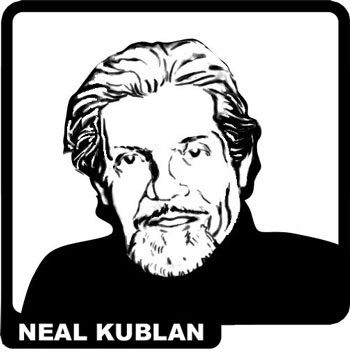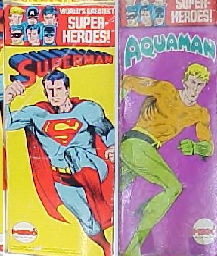
Mego Museum: So how did you start with Mego?
NK: I started when Marty (Mego President Martin Abrams) was still in college, when they were doing $0.88 sales and I left in 1980. The main business was $0.88 sales, which were essentially beginning to dwindle because Marty's Dad Dave, he had always sold department stores what they called the basement department.
The basic concept at one time was excellent, they purchased a certain amount of goods and they received a 10% advertising allowance but what happened was newspaper advertising began to become prohibitivly expensive
{Mego} had also just begun a trading company in the orient called Lion Rock trading as well
When Marty came in the first thing he did was Action Jackson which was a knockoff of GI Joe, the name came from Phil Jackson who later coached the Chicago Bulls
Mego Museum: No, You're kidding me!
NK: Marty's father was a Nicks fan and Phil Jackson was constantly referred to as "Action Jackson". He was the sixth man who came in and always stirred up the team.
Mego Museum: So Action Jackson was the first idea Marty Brought into it ?
NK: Well he didn't bring it in, if I'm not mistaken, it was his dad's idea D. David Abrams, it was Marty's idea to take it to television and he made a change in the structure of the company.
Mego Museum: So Marty brought Mego to TV?
NK: {Marty} brought in a fellow from Ideal who were pioneers in television promotion, his name is Neil Saul, in a way he was my Mentor.
{Mego} hired an ad agency called Hellitzer Advertising, almost sunk the company. Being novices we had no idea as to the rules, things at this time were self goverened by the NAB (National Association of Broadcasters} and everybody played ball with them
The Action Jackson commercials were so loaded with animation
Mego Museum: The figures were done using stop motion animation?
NK:The ones on the tape are later ones, these were all animation, very similar to whats done today but in those days you couldn't do it, much stricter ruling.
By Fall, we were thrown off television
Mego Museum: By the NAB?
NK: Well, they couldn't do it but they called all the stations and they took us off television
Mego Museum: That must have been a scary time.
NK: Yes, it really was but about that time there was an animated cartoon show that ran 4 or 5 days a week called "Worlds Greatest Superheroes", there were three segments, Batman was one and Lone Ranger was one.
(Editots Note: Does anyone remember this? Was it a repackaging of cartoons or live action shows in the NYC area?)
I kind of opted for the name, we were too small a company to get the license but we knew some guys in the product development area called "Leisure Concepts Industries" and we got them to go to LCA (Licensing Corporation of America) which had just become Warner Communications.

They wanted a $50,000 advance for all the characters. We had to get board of directors approval, nobody wanted to spend that much money, Captain Action had been such a disaster
I made a presentation and they went for it and they did a test that Christmas at EJ Corvettes and they checked right out, it was instant
Mego Museum: What did you do in your presentation that convinced them?
NK: I think the whole thing that I convinced them that the cartoon series was doing very well, which I didn't know if it was or not and I convinced them that the Captain Action (concept) wasn't what kids wanted
What we really did is we took an awful lot of Action Jacksons and made new heads and costumes
Mego Museum: Getting back to Action Jackson, was the concept that you could switch the heads?
NK: No, it was a lucky accident, there were a number of those. Some of the material we couldn't use we turned into reprocessed plastic and used over again.
Mego Museum: The Original Four WGSH release was Batman, Superman, Robin and Aquaman?
NK: We filed for the trademark in class 28 for toys for (WGSH) and we got the trademark which subsequently we had to relinquish because Marvel and DC wanted it. I subsequently brokered a deal where all parties had control of the name.
Mego Museum: So did you go in with prototypes of those four characters?
NK: We had no prototypes, we didn't even pitch LCA it was done by LCI. One of the partners of LCI was close friends with a Warners Senoir Executive and there was definitely some personal relationship issues that got it through
Mego Museum: So the first four were made with sold boxes and went into production, how quickly did you discoverthat was not the way to go?
NK: Around February of the next year, the buyers started saying "we can't take these things, the kids rip them open and take the accessories"

Those first closed boxes, those were a disaster, they were designed by a guy named Mike Jamacian who was an instructor in the school of visual arts in NY.
The first Superman by the way, the S was incorrect and it didn't sell
Mego Museum: How was it incorrect?
NK: They put on the S upside down
Mego Museum:I'm going to ask some small details here, why on Batman and Robin did you have plastic belts but on Superman and Aquaman you had vinyl?
NK: It was just the fact that were discovering new methods as you went along and making running changes was very costly because we didn't have our own factory
It was sometimes very difficult to get a factory to change, we were only agents in the orient. Sometimes we couldn't make a change, we could have a 1,000 yards of the vinyl that was only good for stitching and they wouldn't change it until they used that material up
Mego Museum: After the first four (WGSH) how did things proceed?
NK: I can't really tell you the other ones but as soon as we saw how they were selling, we went after the Marvel group.
Mego Museum: So that was Spiderman and Captain America?
NK: That was the only two we started with, Hulk got strong later, there was a TV show with Bill Bixby.
Early on there was a two foot Hulk because we were going to make the Superheroes in 24", big huge blow molded ones. It never got off the ground.
Mego Museum: Captain America, why is his costume not correct? I don't know if it was ever an issue at all.
NK: It was never an issue and I can't say that I honestly remember it. We had an overstock on blue material and even though we knew the details were very important on Batman and Robin, it was not that critical, Captain America was not that great of a seller
Mego Museum: What do you recall about the removable masks on Batman and Robin, why go to painted masks?
NK: Strictly cost savings, one of the most difficult problems we ever had was that we had a difficult time ever raising the price on them
Mego Museum: They were really quite inexpensive.
Because they were originally priced without television promotion in them but as a concept Abrams put the budget across the entire product line, that's no longer done in marketing
NK: In other words, if we released a doll with a million dollar ad budget, we'd only spend half and put the other half on Superheroes as a way of not having to charge with every Superhero half a buck a piece for TV
Mego Museum: I guess that's why they were $1.69?
NK: In '74 or '75, the price of plastic quadrupled in a matter of months and it played havoc with costs, we were paying $0.35 for a figure they were up to a dollar and a quarter in over a period of six months
Mego Museum: 1976 was a big year for Mego, a lot of characters with new features, were you able to add on new features to justify a new cost.?
NK: Both, we were able to add new features but we had to raise the price,
Mego Museum: Do you remember what happened with the Mr Myx's head?
NK: I really can't give you a definitive answer, I know there were two different heads. One of the things may have been that DC turned down the first head and we made some already and just kept shipping them, it's possible
Mego Museum: Did DC and Marvel have different demands on you on how the characters were done?
NK: Not really, although Marvel was more removed from it, at that point it was owned by a company called Cadence industries which also owned Hudson Vitamins
Neal Kublan was Vice President of Mego Research & Development from 1972-1980 and is without a doubt the most important person the Mego Museum has ever spoken to. He found the Museum on the web and was delighted to tell his story and set the record straight.
One Sunday in July, 1998 the Museum's Creator Scott Adams spoke on the phone with Neal about our favorite subject.